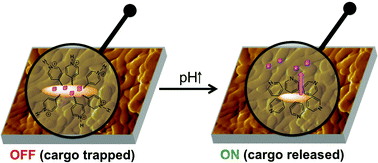

A pH-responsive membrane based on polystyrene-b-poly(4-vinylpyridine) (PS-b-P4VP) block copolymer was developed on a model glass microchip as a promising controlled polymer delivery system. The PS-b-P4VP copolymer assembles into spherical and/or worm-like micelles with styrene block cores and pyridine coronas in selective solvents. The self-assembled worm-like morphology exhibited pH-responsive behaviour due to the protonation of the P4VP block at low pH and it's deprotonation at high pH and thus constituting a switchable “off/on” system. Doxorubicin (Dox) was used as cargo to test the PS-b-P4VP membrane. Luminescence experiments indicated that the membrane was able to store Dox molecules within its micellar structure at neutral pH and then release them as soon as the pH was raised to 8.0. The performance of the cast membrane was predictable and most importantly reproducible. The physiochemical and biological properties were also investigated carefully in terms of morphology, cell viability and cell uptake.
